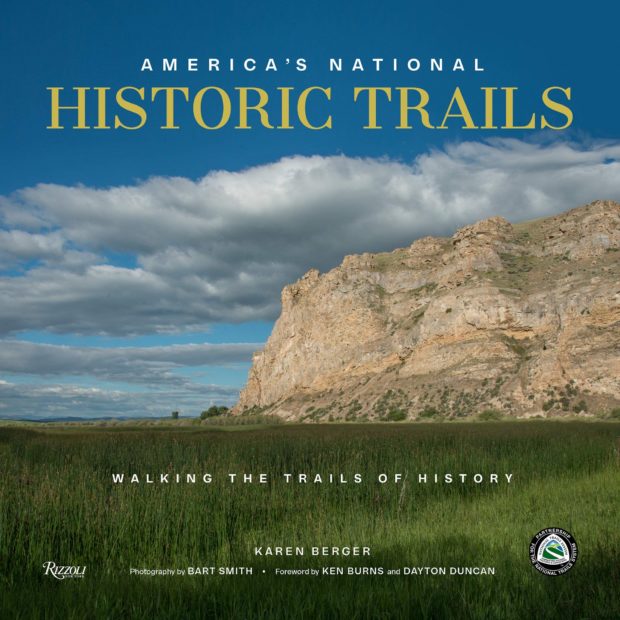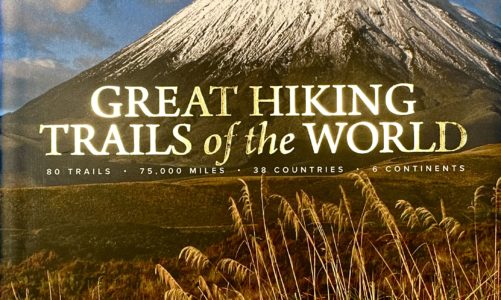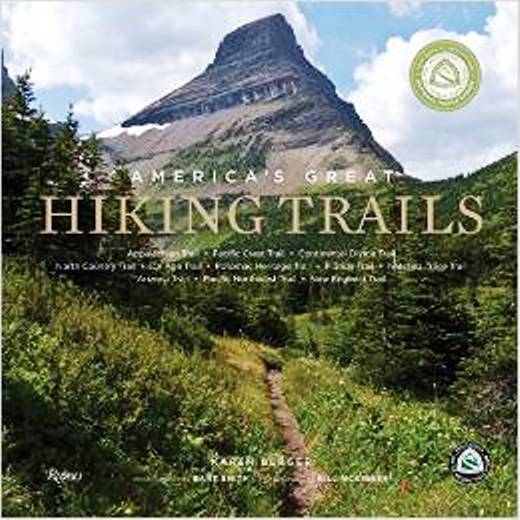America’s National Historic Trails was named one of the year’s best gift books by People magazine. It won the Gold Foreword Magazine/Indie Award for history and a silver National Outdoor Book Award.
Text by Karen Berger. Photographs by Bart Smith. Foreword by Ken Burns and Dayton Duncan. Published by Rizzoli.
About the National Historic Trails
America’s 19 National Historic Trails were selected by Congress as routes of travel that offer and opportunity to experience outstanding recreational opportunities in the landscapes that have been important in American history. Historic events commemorated in the national historic trails system begin with Polynesian settlement in Hawaii and continue through European exploration and conquest, the Revolutionary War, westward migration, Native American conflicts, and the Civil Rights movement.
Some proceeds from the book are donated to the Partnership for the National Trails System.
The following 19 national scenic trails are part of the National Trails System. National Historic are sometimes point to point, as in the case of the Selma to Montgomery Trail and the Pony Express Trail. But equally often, they are networks of historical routes that were used for related purposes. Examples include the California Trail, the Iditarod Trail, and the Camino Real de los Tejas.
Exact mileages are given when those mileages have been officially determined, but in cases of some of the more sprawling trail networks, or when the trails are still being finalized, the mileages are approximate.

Part I: The Spanish Southwest
- El Camino Real de Tierra Adentro Trail
- Commemorates the route of travel that led to the founding of Santa Fe, and which supported Spanish settlement in New Mexico.
- 404 miles from the Mexican-America border in New Mexico to Santa Fe
- El Camino Real de Tierra Adentro Trail Association
- El Camino Real de los Tejas Trail
- Commemorates the royal route that enabled trade between Mexico, Texas, and Louisiana.
- 2580 in Texas and Louisiana
- El Camino Real de los Tejas National Historic Trail Association
- Juan Bautista de Anza Trail
- Commemorates the journey taken to found a settlement and presidio in San Francisco.
- 1200 miles in Arizona and California
- Anza Trail Foundation
- Old Spanish Trail
- Commemorates the route that enabled trade between New Mexico and California.
- 2700 miles in New Mexico, Colorado, Utah, Arizona, Nevada, and California
- Old Spanish Trail Association
Part 2: East Coast
- Captain John Smith Chesapeake Trail
- Commemorates the founding of Jamestown, the explorations of the Chesapeake, and the Indian nations that made their home along the bay and its estuaries.
- 3000 miles in Virginia, Maryland, Delaware, Pennsylvania, New York, and Washington, D.C.
- Chesapeake Conservancy
- Overmountain Victory Trail
- Commemorates the military action that led to one of the seminal Patriot victories during the Revolutionary War.
- 330 miles in Virginia, Tennessee, North Carolina, South Carolina
- Overmountain Victory Trail Association
- Washington Rochambeau Revolutionary Route Trail
- Commemorates the campaign co-directed by Washington and Rochambeau to move troop from Boston to Virginia to lay siege at Yorktown, and ultimately end the Revolutionary War.
- 600 miles in 9 states and the District of Columbia, from Massachusetts to Virginia
- Washington Rochambeau Revolutionary Route, Inc.
- Spar Spangled Banner Trail
- Commemorates the turning point of the War of 1812 and the events that led to the writing of the American national anthem.
- 290 miles in Maryland, Virginia, and the District of Columbia
- Chesapeake Conservancy
Part 3: Westward Expansion
- Lewis and Clark Trail
- Commemorates Lewis and Clark’s journey to the Pacific Ocean and back in one of the most extensive, detailed, and arduous scientific, cultural, and geographic explorations in history.
- 4900 miles in 16 states from Pennsylvania to Washington
- Santa Fe Trail
- Commemorates the route that opened trade between Missouri and the Mexican southwest.
- 1200 miles in Missouri, Kansa, Oklahoma, Colorado, and New Mexico
- Sant Fe Trail Association
- Oregon Trail
- Commemorates the route that led to the settlement of the Pacific Northwest.
- 2200 miles through 7 states from Missouri to Washington
- Oregon-California Trails Association
- Mormon Pioneer Trail
- Commemorates the religious emigration of Mormon pioneers, looking to found a settlement where they could practice their religion without conflict from non-Mormons.
- 1300 miles through Illinois, Iowa, Nebraska, Wyoming, and Utah
- Mormon Trails Association
- California Trail
- Commemorates the gold rush-fueled flood of emigrants who traveled to California and laid the groundwork for America’s now most populous state.
- 5665 miles through 10 states from Missouri to California and Oregon
- Oregon-California Trails Association
- Pony Express Trail
- Commemorates the short-lived mail delivery service that enabled communication from sea to sea.
- 1966 miles through 8 states from Missouri to California
- National Pony Express Association
- Iditarod Trail
- Commemorates the role of sled dogs in the history of backcountry Alaska.
- 2300 miles through Alaska
- Iditarod Historic Trail Alliance
Part 4: American Diversity
- Ala Kahakai Trail
- Commemorates the routes of travel through religious sites and homesteads dating from the earliest Polynesian settlers to the Big Island of Hawai’i.
- 175 miles in Hawai’i
- Ala Kahakai Trail Association
- Trail of Tears Trail
- Commemorates the brutal forced relocation of the Cherokee from their homes in the southern Appalachians to Oklahoma.
- 5045 miles through 9 states from Georgia to Oklahoma
- Trail of Tears Trail Association
- Nez Perce (Nee-Me Poo) Trail
- Commemorates the fighting flight of the Nez Perce as they tried to escape from forced relocation to a reservation.
- 1270 miles through Oregon, Idaho, Wyoming, and Montana
- Nez Perce Trail Foundation
- Selma to Montgomery Trail
- Commemorates the Voting Rights March of 1965.
- 54 miles in Alabama
- National Park Foundation

